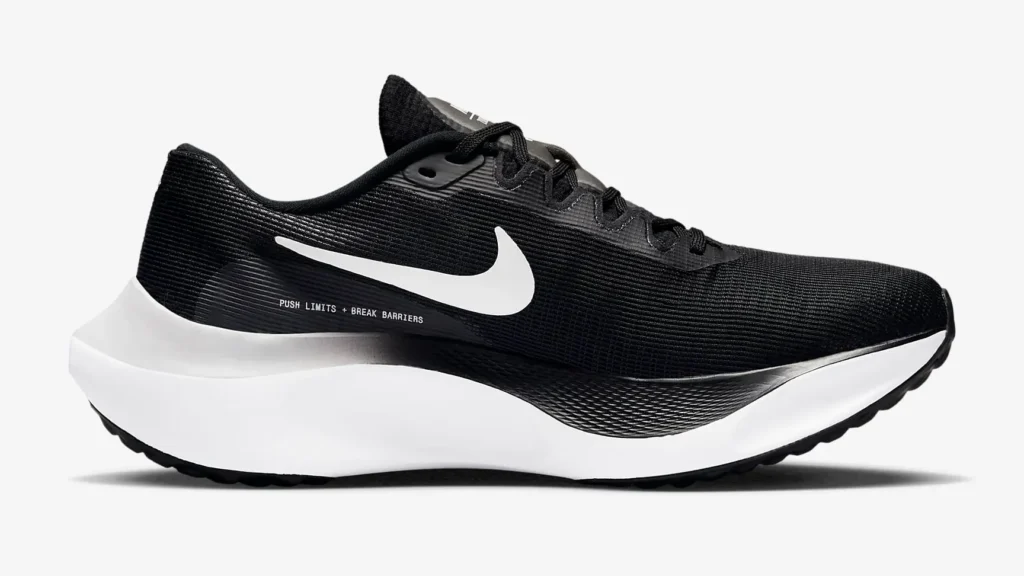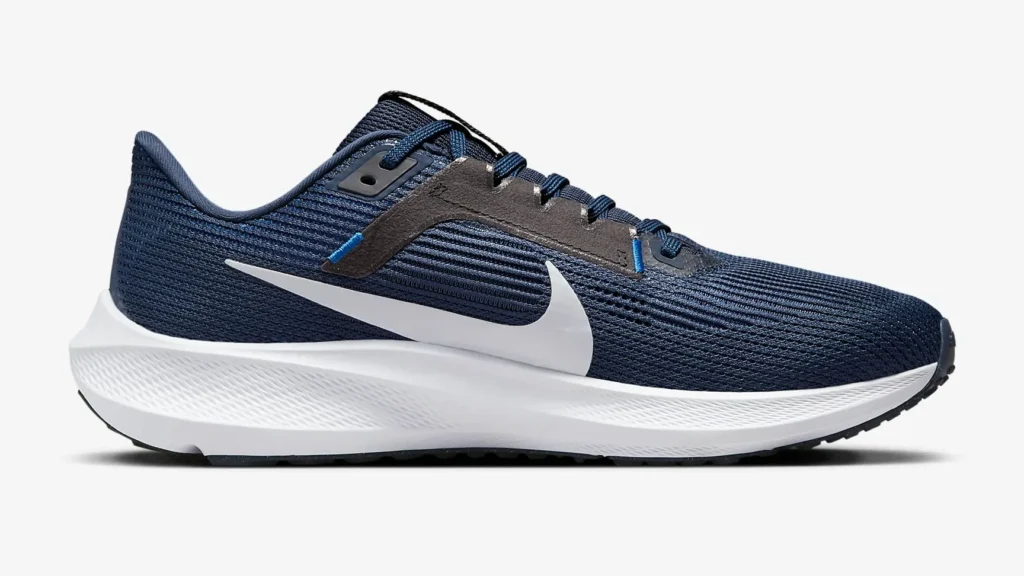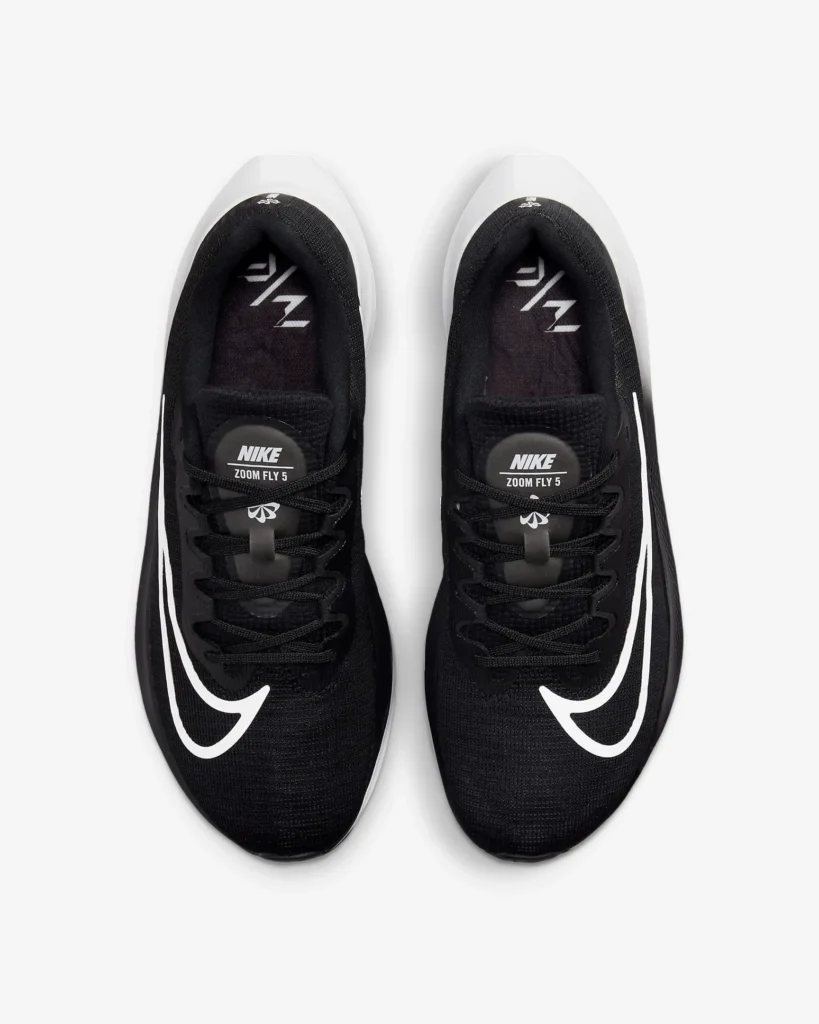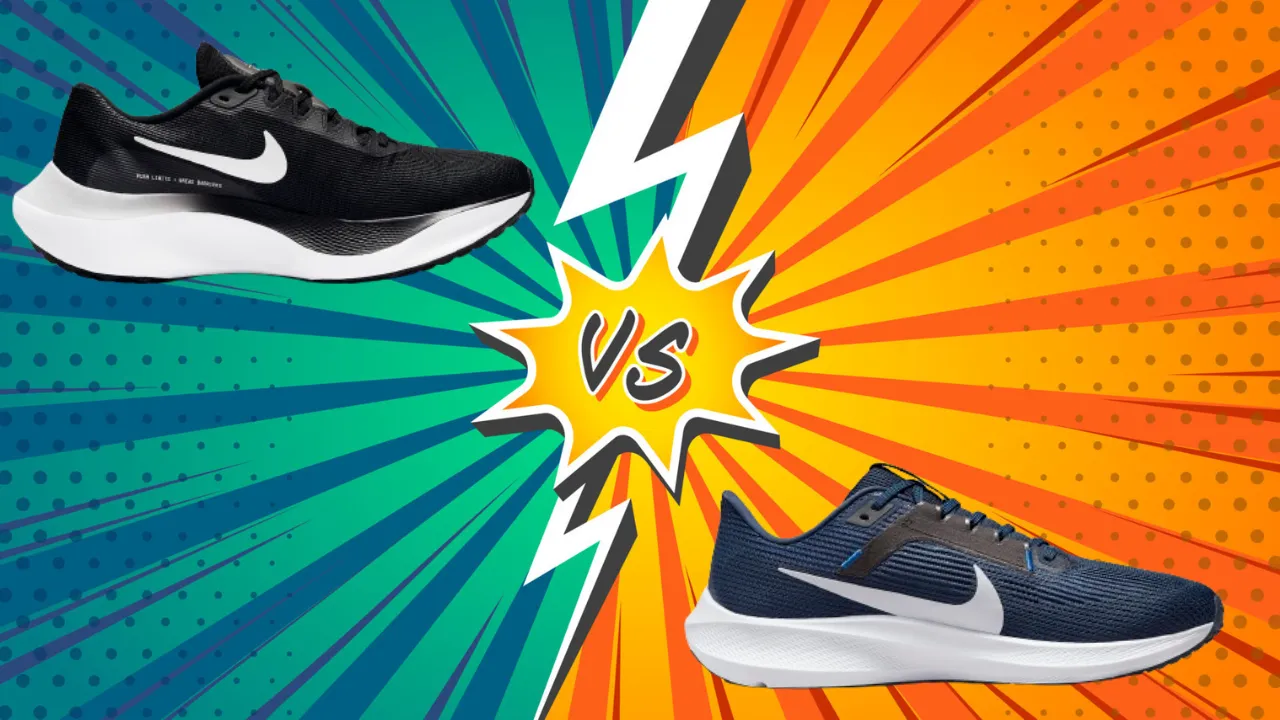Running is a great way to stay fit and healthy, but choosing the right running shoes can make a huge difference in your comfort and performance. Two popular options are the Nike Zoom Fly 5 and the Nike Pegasus 40.
Both are designed to give you a smooth, cushioned ride, but they have some distinct differences that might make one a better choice for you. In this comparison, we’ll break down the key features, materials, and performance of these two shoes to help you decide which one is the perfect fit for your running needs.
Comparison Table between Nike Zoom Fly 5 and Pegasus 40:
| Feature | Nike Zoom Fly 5 | Nike Pegasus 40 |
|---|---|---|
| Launched In | 2022 | 2023 |
| Stability | Less Stable | Moderate |
| Flexibility | Less Flexible | Excellent |
| Sizing | True to Size | True to Size (MR-10 Last) |
| Weight | 314g | 288g |
| Cushion | ZoomX Foam + Carbon Fiber Plate | React Foam + Forefoot & Heel Zoom Air Units |
| Outsole | Waffle-inspired Rubber | Waffle-inspired Rubber |
| Midsole | ZoomX Foam + Carbon Fiber Plate | React Foam + Zoom Air Units |
| Upper | Lightweight Mesh | Breathable Engineered Mesh |
| Retail Price | $170 | $130 |
Features Comparison:
Materials:
The Nike Zoom Fly 5 features a lightweight mesh upper for breathability and a soft, conforming fit. The midsole incorporates responsive ZoomX foam and a carbon fiber plate for a propulsive sensation.


The Pegasus 40, on the other hand, boasts a breathable engineered mesh upper and a midsole with React foam and Zoom Air units in the forefoot and heel for a balanced, springy ride. Both shoes utilize a waffle-inspired rubber outsole for traction and flexibility.
Durability:
When it comes to durability, both shoes are built to withstand the demands of regular running, but the Pegasus 40 may have a slight edge. Its more traditional construction, with an engineered mesh upper and React foam midsole, is designed to hold up better over time.
The Zoom Fly 5’s lightweight mesh upper and ZoomX foam midsole, while offering great responsiveness, could be more prone to wear and tear after extended use. However, it’s worth noting that the durability of any shoe also depends on factors like your running style, body weight, and the surfaces you run on.
Fit:
Finding the right fit is crucial for a comfortable and efficient running experience. The Nike Zoom Fly 5 and Pegasus 40 both aim to provide a secure, snug fit, but they go about it in slightly different ways. The Zoom Fly 5 features a dynamic lace-up system and supportive midfoot wrap that hugs your foot for a contoured, locked-in feel.


The Pegasus 40, on the other hand, relies on a plush collar, tongue, and sockliner to create a cozy, secure fit. Both shoes are designed to fit true to size, but the Pegasus 40 uses Nike’s MR-10 last for a consistent, reliable fit across a range of foot shapes.
Cushioning:
The Nike Zoom Fly 5 provides responsive cushioning with its ZoomX foam midsole and carbon fiber plate, delivering a propulsive sensation. The Pegasus 40
On the other hand, offers a balanced, springy ride with its combination of React foam and Zoom Air units in the forefoot and heel. The Zoom Fly 5 may feel slightly more responsive, while the Pegasus 40 could provide a smoother, more cushioned feel.
Stability:
The Nike Zoom Fly 5 offers slightly wider bases in the forefoot and heel for a stable platform, but it’s generally less stable than the Pegasus 40. The Pegasus 40 provides moderate stability with its redesigned midfoot for a more secure and forgiving sensation. If you require more stability during your runs, the Pegasus 40 may be the better choice.
Value for Money:
At $170, the Nike Zoom Fly 5 is a premium offering with advanced features like the ZoomX foam and carbon fiber plate. The Pegasus 40, priced at $130, provides a more affordable option with reliable cushioning and a versatile design.
If you’re looking for a high-performance shoe and don’t mind the higher price tag, the Zoom Fly 5 could be worth the investment. Otherwise, the Pegasus 40 offers excellent value for its feature set.
Performance Comparision:
For Walking:
Both the Nike Zoom Fly 5 and the Pegasus 40 can provide a comfortable walking experience. The Zoom Fly 5’s ZoomX foam and carbon fiber plate offer a responsive, propulsive feel that could make walking feel more energetic.
The Pegasus 40’s combination of React foam and Zoom Air units provides a balanced, cushioned ride that may be better suited for longer walking sessions. Ultimately, the choice may come down to personal preference and whether you prefer a more responsive or cushioned feel.
For Running :
The Nike Zoom Fly 5 and Pegasus 40 are both designed with running in mind, but they cater to different preferences. The Zoom Fly 5’s carbon fiber plate and ZoomX foam deliver a propulsive sensation and a smooth transition at various paces, making it an excellent choice for those seeking a responsive, fast-feeling ride.
The Pegasus 40, with its combination of React foam and Zoom Air units, offers a more traditional, cushioned feel that may appeal to runners preferring a softer, more forgiving ride.
For Standing All Day:
When it comes to standing for extended periods, the Nike Pegasus 40 may have an advantage over the Zoom Fly 5. The Pegasus 40’s combination of React foam and Zoom Air units provides excellent cushioning and support, which can help alleviate fatigue and discomfort during prolonged standing.
The Zoom Fly 5’s ZoomX foam and carbon fiber plate are designed more for a responsive, propulsive feel during running, and may not offer the same level of cushioning and support for extended standing periods.
For Plantar Fasciitis:
Both the Nike Zoom Fly 5 and Pegasus 40 could potentially be suitable options for individuals with plantar fasciitis, but the Pegasus 40 may have a slight edge. Its combination of React foam and Zoom Air units provides ample cushioning and support, which can help alleviate the stress and discomfort associated with plantar fasciitis.
The Zoom Fly 5’s carbon fiber plate and ZoomX foam may offer a more responsive ride, but the cushioning may not be as forgiving for those with plantar fasciitis.
Conclusion: Which Is Better For You?
In the battle between the Nike Zoom Fly 5 and the Pegasus 40, there is no clear winner – it ultimately comes down to your individual preferences and needs. The Zoom Fly 5 excels in delivering a responsive, propulsive ride, making it an excellent choice for those seeking a fast-feeling shoe for running.
On the other hand, the Pegasus 40 offers a more traditional, cushioned feel and moderate stability, catering to runners who prioritize comfort and support. Consider factors like cushioning, stability, and intended use to determine which shoe aligns better with your running goals and preferences.

